Posts Tagged ‘Simeon Cortezano’
This week in Magic: Looking at the new Standard
Friday, October 9th, 2015
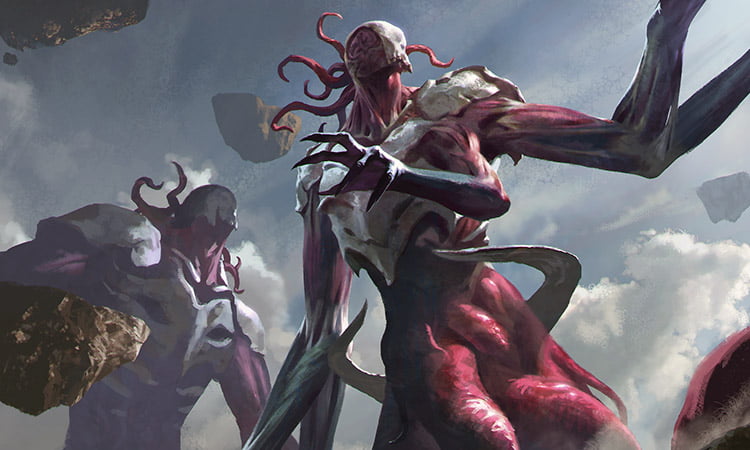
It’s that time again. Time for another edition of This week in Magic. As you could tell, we took a little break last week because things were getting a little stale, but now that Standard tournaments have been reporting in with the latest rotation, we’ve finally got something to talk about. Last week, the SCG Open was in Indianapolis. If you were one of the many viewers tuning in, then you got to see some of the great new decks to hit the tournament scene. A quick look at the Top 8 shows that Abzan is still alive and kicking. At the same time, Jeskai and Esper managed to make the trip as well.
There were two decks, though, that really stood out among the crowd. Those two decks were a 5-color Bring to Light deck and an Atarka Red Aggro deck. Now the Atarka Red Aggro deck is something that many players saw coming. A Red based aggro deck is usually expected at the beginning of every new Standard rotation. Bring to Light was a card many were excited about, but it was unclear as to how this card would get played. Well, it seems that we finally have an answer. Let’s take a look at the list that made the Top 8.
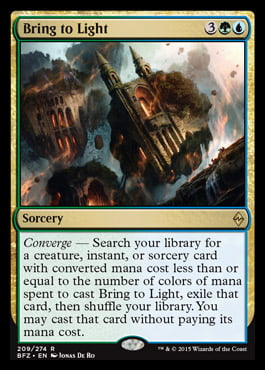
5C Bring to Light
by Gerry Thompson – 5th place
4 Jace, Vryn’s Prodigy
4 Siege Rhino
2 Nissa, Vastwood Seer
1 Silumgar, the Drifting Death
1 Gilt-Leaf Winnower
1 Clever Impersonator
4 Bring to Light
4 Abzan Charm
2 Disdainful Stroke
2 Murderous Cut
2 Reave Soul
1 Crux of Fate
1 Ugin’s Insight
1 Languish
1 Ruinous Path
1 Utter End
1 Sultai Charm
4 Polluted Delta
4 Flooded Strand
3 Bloodstained Mire
2 Lumbering Falls
2 Windswept Heath
2 Forest
1 Wooded Foothills
1 Shambling Vent
1 Plain
1 Island
1 Swamp
1 Canopy Vista
1 Sunken Hollow
1 Cinder Glade
1 Prairie Stream
1 Smoldering Marsh
For now, we’re going to concentrate on just the core aspect of the deck. We’ll look at the sideboard another time. If you couldn’t tell by now, the key to the deck is Bring to Light. Don’t let the look of this sorcery fool you. It’s proven to be quite a powerful tutor. In a lot of the games captured on camera during the tournament, the best thing it could tutor for was Siege Rhino. It’s one thing for deck to naturally draw multiple Rhinos in a row, but playing Bring to Light essentially gives you Siege Rhinos number 5-8.
In addition to being able to stomp all over your opponent with Rhinos it has incredible reach. The deck has an unusual number of 1’s and 2’s in the deck list, but as long as you have the mana, Bring to Light can grab anyone of the limited spells in your deck. Also, thanks to Jace, you can use these spells more than once if needed.
So how do you play against a deck like this? Well, one thing is for sure, I don’t think this is an easy deck to play. This looks like one of those situations where if the person piloting the deck doesn’t know how to play it well, it could potentially implode on itself, but don’t always count on that. Bring to Light is one of the keys to the deck. If you take it out of the equation, you chances of winning increase. So, spells like Duress or anything that will disrupt your opponent’s hand may do the trick. There is also a lack of counters in the deck which means it could run into some serious trouble against heavy control decks.
Atarka Red is a deck that will probably stick around for a while. Mono Red was really hurt with the rotation of Theros and M15. So like any good deck, it adapted to the changes and has transformed itself from a burn deck to one of the most aggressive decks in the format. Let’s take a look at the list.
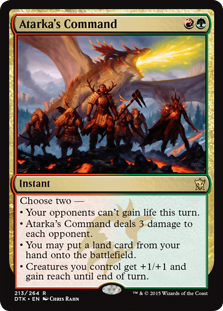
Atarka Deck Wins
by Brian Demars – 1st place
4 Zurgo Bellstriker
4 Abbot of Keral Keep
4 Monestary Swiftspear
2 Lightning Berserker
2 Chandra, Fire of Kaladesh
1 Makindi Sliderunner
4 Wild Slash
4 Atarka’s Command
4 Titan’s Strength
4 Dragon Fodder
3 Become Immense
3 Temur Battle Rage
8 Mountain
4 Bloodstained Mire
4 Wooded Foothills
2 Cinder Glade
2 Windswept Heath
1 Forest
As you can see, there is nothing special about this deck. It’s very straight forward – play a bunch of creatures and smash your opponent as fast as you can. Like a lot of aggro decks, there isn’t much of a late game. So, if your opponent begins to stabilize with fatter creatures, you could find yourself in some trouble. This shouldn’t be the case, though. You should be playing spells without much hesitation because you want to be able to fill your graveyard in order to make things easier when casting Become Immense. The green pump spell plus Temur Battle Rage should be more than enough to finish your opponent even if they have a blocker.
About the author
Simeon is now the Community Manager for Battleground Games & Hobbies. If you have any questions or inquiries, then you can reach him at Sims@battlegroundgames.com. He is also an avid gamer who loves to play board games and video games. He graduated college with a degree in Political Science, and now serves the public by writing about games. You can check that out here. Don’t forget to “like” him on Facebook as well. It’ll update you on all of his newest content. Best of all, you can follow Simeon on Twitter (@SimeonCortezano) for some real time hilarity. Thanks for reading!
The Extra Life 2015 campaign is underway. Donate today!

Join the Battleground Games & Hobbies community forums!
Please don’t forget to check us out on Facebook and follow us on Twitter @battleground_gh!
Tags: Magic the Gathering, MTG, Simeon Cortezano, Standard
Posted in Blog, Card Games, Featured Author, Featured Post, Magic: The Gathering, Popular Posts | No Comments »
This week in Magic: Pro Tour vs. other events
Friday, September 4th, 2015
Welcome back to another “This week in Magic.” A couple of weeks ago we sparked some controversy with our Jace vs. Jace list. I’m not saying you have to agree with me. In fact, I’m glad those of you who didn’t agree told me. More than anything, I want people to engage in conversation here. With that being said, I’m not writing things for the sake of arguing. The Jace vs. Jace list was something that I truly believe in.
For this week’s topic we’re going to go over Pro Tour tournament results vs. SCG Open Series results.
As someone who plays Magic at a competitive level, I like to see what other people are playing nowadays. Some of the best resources around the net to find this kind of information are MTGTop8.com, TCGPlayer, StarCityGames, or directly from DailyMTG.com. Usually a couple of days after the tournament, these sites will post the Top 8 results. On StarCity’s site, they typically have it the same day since they’re the one’s hosting some of the events.
Personally, I like to look at the results of events like the StarCity Open Series more than the Pro Tour. Sometimes I like looking up the results of local tournaments such as 1Ks or 5Ks. These events tend to draw up to several hundred people, and, in some occasions, high level players and even pros show up if it’s close enough to them.
Playing the numbers game
So I’m sure you’re wondering right now why I prefer these “local” tournaments over the Pro Tour. The biggest reason why is that the Pro Tour is sometimes made up of different formats. For example, Pro Tour Origins was both Standard and Origins Limited. So while someone like Shahar Shenhar may win the Pro Tour, he may have done so by having an amazing Limited record while limping with a sub-par Standard record.
At an event like a TCG5K, players have to go through upwards of nine rounds of Standard Swiss (or whatever format is defined for the tournament) and then a Top 8. That’s clearly more than the three or four rounds that pro players endure at a Pro Tour. So what an event like a TCG5K shows is how much a deck can endure.
A pro is still a pro
Admittedly, a pro player is still a pro player. They are a pro for a reason, and that reason is because they’re good, they know how to win, and did I mention that they’re good? At an SCG event, any Joe Schmoe can win that event. No offense to anyone named Joe or with the last name Schmoe, but I’m mainly referring to someone like me; of my caliber. Keep in mind, you have to earn your way onto a Pro Tour. You can’t just show up, pay the $50 at the door (ugh) and play. Players on the Pro Tour have earned their way by either having been there already, or qualifying.
To qualify for a Pro Tour today seems a lot more tedious than it has in the past. With PPTQs, local stores can rejoice and be happy that they get to host such prestigious events, but it just means more work for the local player. In the past, you would show up to a single qualifier. At that point, you either win it or you don’t. Those events could, sometimes, yield upwards to a hundred players. A local PPTQ can actually come close, but averages somewhere between 30-50 players.
Experience is still better than showing up
If there were ever an argument to change my mind it would have to be that a pro player is playing a certain deck at the pro tour because of reasons that I am not experienced enough to initially see. I guess you could say that this all goes back to how “a pro is still a pro.”
I think it’s safe to say that all Magic players want to win. They don’t want to just scrape by enough to make it, they want it all. So, to say that a pro player would ever be satisfied with “just making it” at a pro tour with a sub-par performance is like an insult to them. If they could, they’d like to replicated something similar to Seth Mansfield’s run at World’s last week. He would end up being crowned champion with an amazing 13-1 record overall.
To do this at the game’s highest stage is one of the best things you could do in this game. For Seth, it was clear how much it meant to win. I was telling others that if I had won, I would have had the worst case of “ugly face” due to all the crying I would have done.
I’d really like to know your thoughts on this matter. This is especially for those of you who have taken up the oath to never “netdeck” a list. How do you, as a player, conduct your research to prepare for the current meta, whether it’s an FNM or a major local event? Let us know in the comment section below.
About the author
Simeon is now the Community Manager for Battleground Games & Hobbies. If you have any questions or inquiries, then you can reach him at Sims@battlegroundgames.com. He is also an avid gamer who loves to play board games and video games. He graduated college with a degree in Political Science, and now serves the public by writing about games. You can check that out here. Don’t forget to “like” him on Facebook as well. It’ll update you on all of his newest content. Best of all, you can follow Simeon on Twitter (@SimeonCortezano) for some real time hilarity. Thanks for reading!
The Extra Life 2015 campaign is underway. Donate today!

Join the Battleground Games & Hobbies community forums!
Please don’t forget to check us out on Facebook and follow us on Twitter @battleground_gh!
Tags: Magic the Gathering, MTG, Simeon Cortezano
Posted in Blog, Card Games, Featured Author, Featured Post, Magic: The Gathering, Popular Posts | No Comments »
This week in Magic: Battle for Zendikar
Friday, August 28th, 2015
Welcome back for another edition of This “This week in Magic.” For this week’s topic, we’re going to cover some of the cards that have already been spoiled for the upcoming Battle for Zendikar expansion which is set for release this September. In fact, this is a big weekend for Magic because PAX Prime is currently underway. At the convention, there will be a Magic panel where we’ll learn more about the set and many cards are poised to be spoiled. For now, let’s talk about what we already know about.
Guardian of Tazeem
This is a really solid card at first glance. Five mana is a little hefty, but it’s made up in the card’s other abilities. As a flying 4/5 I can almost completely forgive the card for costing so much. Ideally, the only place for this card is in a control deck. Playing it in a UB Control list would make the most sense. However, with the dragons still being in play, this probably won’t happen until post rotation.
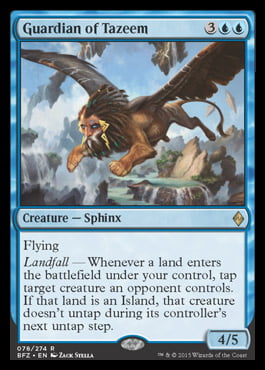
“Old school” players wlill be happy to see the return of Landfall to Standard. This is particularly exciting because we’ll still have the fetchlands in the format making Landfall that much more powerful. In a control deck, the ability to tap down creatures is a great advantage. The added ability to keep the tapped if you played an island (in an already heavy island deck) seems like icing on the cake.
At this point, it seems like Battle for Zendikar is already shaping up. Remember, though, we’re only on our first card!
Oblivion Sower
Our first look into what the Eldrazi have been up to and it’s a doozy. In typical Eldrazi form, it’s an awkward 5/8 for six mana. Still, standing tall at 5/8 means it hits hard and is hard to kill. Even better, it’s it takes six colorless mana to cast. Due to this, Modern players perked up and asked, “can this go into Tron decks?” However, the real question is, “can this replace Wurmcoil Engine?” In my opinion, I don’t think so. I would definitely consider it as a sideboard option, but it would depend on whether or not Battle for Zendikar will change the shape of Modern.
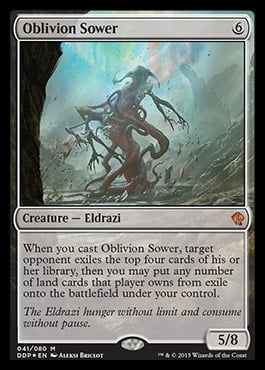
In Standard, Oblivion Sower may see play. Thanks to it being colorless means it could fit in almost any deck. In the past, the Eldrazi were found in, typically, Mono Green and Mono White. I know I keep going back to it, but I could even see Eldrazi making an appearance in UB Control. The reason I keep going back to that deck is because the deck usually aims for the late game, is mana hungry, and tends to play larger spells because of it’s heavy control aspect.
One way or another, when Oblivion Sower ever hits the board, whoever is facing is going to have a rough time if it ever makes contact with them. Why? Have you seen what it does. First of all, it exiles the top four cards of your opponent’s deck. To add insult to injury, if any of those cards are lands, you get to put them into play under your control. Combined with the Landfall mechanic, this is positioned to be a major player in the game.
Casual player or not, you may want to consider pre-ordering a playset of these guys just in case.
Dominator Drone
Keeping in line with the colorless theme, Dominator Drone introduces a new mechanic to the game. One that is not entirely surprising. Devoid is the new mechanic that causes a card to have no color even if there is a colored mana symbol in its casting cost. So, why does this matter? For instance, this will make card like Surge of Righteousness less effective since it requires, specifically, a red or black creature.
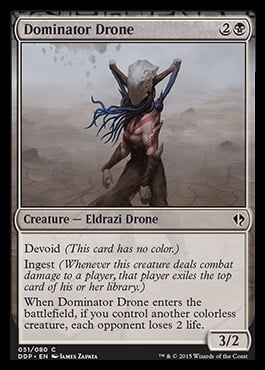
Dominator Drone also introduces the Ingest mechanic. Ingest says that “whenever [the] creature deals combat damage to a player, that player exiles the top card of his or her library.” This looks like a really annoying mechanic to face. By annoying, I mean if you’re the one facing it. Otherwise, this looks like a lot of fun. Given enough creatures with Ingest, I wonder if it will be possible to create an Ingest themed deck.
My prediction is that there will be a spell that gives all your creatures Ingest until the end of the turn. Can you imagine a fleet of tokens attacking you and each one has Ingest. Ugh…
Sheer Drop
The last card we’re going to look at today is Sheer Drop. Off the bat, this card looks like a glorified draft card. So there is little chance it will ever seen constructed play. It doesn’t do anything special, but it does introduce another new mechanic known as Awaken. The mechanic allows you, for an alternate casting cost, to cast a spell and place a certain number of counter on a land turning it into a creature that is still a land with a power and toughness equal to the number of counters placed on it.
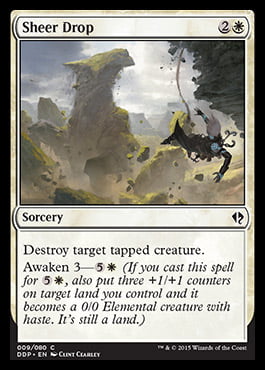
Essentially, if you case the a spell for it’s Awaken cost, you’re getting a two-for-one. Depending on the cost, Awaken could be a very interesting mechanic in Standard. In Limited, though, it may prove to be a serious mechanic since spells do not come at a premium.
Well that’s it for this week. What are you looking forward to in Battle for Zendikar? Is there anything you hope makes an appearance in the set? Let me know in the comments below! Until next week…
About the author
Simeon is now the Community Manager for Battleground Games & Hobbies. If you have any questions or inquiries, then you can reach him at Sims@battlegroundgames.com. He is also an avid gamer who loves to play board games and video games. He graduated college with a degree in Political Science, and now serves the public by writing about games. You can check that out here. Don’t forget to “like” him on Facebook as well. It’ll update you on all of his newest content. Best of all, you can follow Simeon on Twitter (@SimeonCortezano) for some real time hilarity. Thanks for reading!
The Extra Life 2015 campaign is underway. Donate today!

Join the Battleground Games & Hobbies community forums!
Please don’t forget to check us out on Facebook and follow us on Twitter @battleground_gh!
Tags: Battle for Zendikar, Magic the Gathering, MTG, Simeon Cortezano, zendikar
Posted in Blog, Card Games, Featured Author, Featured Post, Magic: The Gathering, Popular Posts | No Comments »
This week in Magic: Jace vs. Jace
Friday, August 21st, 2015
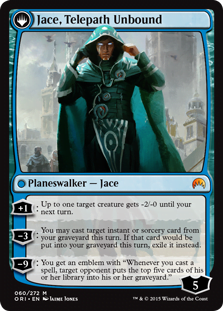
Welcome to another “This week in Magic.” Let’s take a break from discussing decks. Today we’re going to rank all of the Jaces in order from worst Jace to the best Jace.
I recently had a discussion regarding which Jace, over the years, was the best one. While we knew which Jace was not the top choice, we knew which ones to argue about. First, let me remind you of the different Jaces (in no particular order):
Jace Beleren
Jace, The Mind Sculptor
Jace, Memory Adept
Jace, Architect of Thought
Jace, The Living Guildpact
Jace, Telepath Unbound
6. Jace, The Living Guildpact
At the bottom of the list has to be The Living Guildpact. The key to a solid version of Jace is the ability to take care of himself. At +1 loyalty, this version of Jace manipulates the top of your deck and your graveyard. At -3 loyalty, Jace bounced another nonland permanent back to it’s owner’s hand. While the possibility of bouncing a threat may prolong Jace’s life for a little bit, the fact that he leaves himself with only two loyalty means that even 1/1 tokens pose a threat. Finally, his ultimate ability just didn’t have the power that the other Jace’s have. In the end, for his lack of ability, The Living Guildpact earns the bottom slot on our list of Jace’s.
5. Jace, Memory Adept
While he’s only one place higher than the bottom, this version of Jace is leaps and bounds above The Living Guildpact. At five mana, this was the most expensive Jace to play. However, his abilities did a lot of the talking. The Memory Adept was key in a lot of control mirror matches. Whoever was able to play their Jace first usually won, and may the Magic gods have mercy on your soul if you didn’t have a copy in your sideboard. The funny thing about this Jace is that most players only cared about one ability. That ability was the zero loyalty ability. If this version of Jace hit the board, those facing him were on a three or four turn clock after that. Due to his ability to end the game quickly is why we can forget that this Jace cannot defend himself from harm and why he ranks better than last.
4. Jace, Architect of Thought
I guess when you have a small cast of characters, one should not be surprised by how low some of them may look on the totem pole. Don’t be fooled by the Architect of Thought’s placement at number 4. One of the biggest mistakes made with this Jace was being compared to The Mind Sculptor when he was first spoiled. Many thought he was trying too hard to be like his big brother. He took a while, but the Architect of Thought eventually made a name for himself. In fact, he’s even seeing play in Modern. This Jace had the whole package. He could defend himself, he gave you card advantage, and his ultimate actually mattered in some matches. Out of all the Jaces, this is the most balanced.
3. Jace Beleren
Also known as “baby Jace,” Jace Beleren is the original. If this were a popularity contest, Jace Beleren would win the crown. Unfortunately, this isn’t. This is about power. Imagine being there the first time baby Jace was introduced to the world. Blue mages all over the world rejoiced. However, once they had their taste of power, they wanted more and so didn’t R&D. Even if you got just one card out of Jace, the fact that it only cost three mana to play was very important. Not only was this Jace cheap, but it gave you card advantage. To top things off, giving him a mill ability was his ultimate was icing on the cake. Baby Jace made Turbo Fog decks what they were in the past. Without him, who knows where the state of Planeswalkers would be today.
2. Jace, the Mind Sculptor
I’m pretty sure that 95% of you are screaming at me right now. How can I rank something that is broken as number two? Easy, I think the remaining Jace is better. The Mind Sculptor will go down in history as one of the most powerful version of Jace to exist; so powerful that it was indirectly declared a mistake to have made this card.
I don’t think there was one bad thing about this card. At +2 loyalty, you had the ability to soft lock your opponent by knowing every card they were going to draw, even manipulating what they were going to draw. At 0, you had a Brainstorm-on-a-stick. At -1 loyalty, you could bounce any problems back to their owner’s hand or a solution back to your own. Finally, at -12 loyalty, The Mind Sculptor’s ultimate ability meant the end of most games. The card was too good to be true, and I doubt there will ever be anything like him again.
1. Jace, Telepath Unbound
This is the Architect of Thought all over again. Like its predecessor, many people didn’t think much of this Jace when it was first spoiled. However, over time almost everyone who has played him has been surprised and versatile by how he responds to most situations. I guess the real question is why is the Telepath Unbound number one in my book?
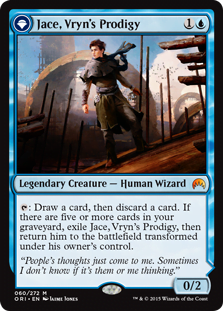
First of all, he is the cheapest Jace to play. Although he does not first make an appearance as a Planeswalker, it doesn’t take much to ignite his “spark” and flip him into one. So, before we get the benefits of his Planeswalker abilities, we get treated by his creature abilities as a looter. One of the best uses for this Jace is to use him as a blocker and then turn him sideways to flip him into a Planeswalker (barring you have enough cards in the graveyard to do so). Once flipped, use him as you see fit.
At +1 loyalty he can protect himself or you. At -3 loyalty, he becomes reminiscent of one of the most powerful mages in the multiverse. Lastly, at -9 loyalty, you get an emblem that could ruin almost any player’s day.
The fact of the matter is that the Telepath Unbound is number in my book because of how versatile it can be. I understand that some of you will disagree. How can the Mind Sculptor (with his four abilities) be less versatile than the Telepath Unbound (with only his three abilities)? The new version of Jace edges out the Mind Sculptor by just an inch and that inch is it’s ability to go from creature to Planeswalker.
That’s it for this week. What did you think? Agree? Disagree? I would love to hear your opinion. Feel free to leave a comment below letting us know what you think. Until next time…
About the author
Simeon is now the Community Manager for Battleground Games & Hobbies. If you have any questions or inquiries, then you can reach him at Sims@battlegroundgames.com. He is also an avid gamer who loves to play board games and video games. He graduated college with a degree in Political Science, and now serves the public by writing about games. You can check that out here. Don’t forget to “like” him on Facebook as well. It’ll update you on all of his newest content. Best of all, you can follow Simeon on Twitter (@SimeonCortezano) for some real time hilarity. Thanks for reading!
The Extra Life 2015 campaign is underway. Donate today!

Join the Battleground Games & Hobbies community forums!
Please don’t forget to check us out on Facebook and follow us on Twitter @battleground_gh!
Tags: jace, Magic the Gathering, MTG, Simeon Cortezano
Posted in Blog, Card Games, Featured Author, Featured Post, Magic: The Gathering, Popular Posts | No Comments »
This week in Magic: UR Mill
Friday, August 14th, 2015
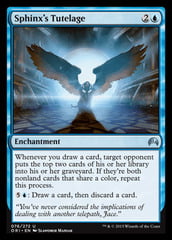
Welcome to another week of “This week in Magic.” Today we’re going to talk about a really surprising deck, UR Mill. Believe it or not, this deck actually won GP San Diego last week and there is a good chance a lot of people will be playing it at their FNMs. We’re going to break down the deck and see what made it so successful and what the possible downsides are.
First, let’s take a look at the decklist.
UR Mill by Michael Majors
1st place – GP San Diego
Maindeck
4 Treasure Cruise
4 Anger of the Gods
4 Tormenting Voice
4 Magmatic Insight
2 Whelming Wave
2 Send to Sleep
2 Roast
1 Dig Through Time
4 Jace, Vryn’s Prodigy
4 Sphinx’s Tutelage
1 Monastery Siege
1 Alhammerret’s Archive
5 Mountain
4 Shivan Reef
4 Swiftwater Cliffs
4 Radiant Fountain
4 Island
4 Temple of Epiphany
1 Flooded Strand
1 Bloodstained Mire
Sideboard
1 Whelming Wave
4 Negate
3 Annul
4 Firey Impulse
1 Disperse
1 Encase in Ice
1 Seismic Rupture
At first glance, one could ask themselves, “How does this thing win?” After watching it several times, this deck seem to just win out of no where. One of the key spells in this deck has to be the four copies of Anger of the Gods. Without this spell, the deck would never survive the early onslaught of decks like Mono Red, Elves, Abzan Aggro, and UR Thopters.
For those who are too big to be killed by Anger of the Gods, we have spells like Send to Sleep and Roast. Players just need to buy themselves enough time to set themselves up. Once the engine is up and running, it’s very hard to overcome it. Now what makes it so hard to overcome?
The reason why the deck is hard to beat when the engine is running is due to it’s cheap and very efficient draw spells. We’re talking cheap and efficient enough to be able to skip the fog portion of the deck. Although, some would argue that the Anger of the Gods are all the fog that the deck needs. Imagine this very realistic scenario: Turn one play a mountain and cast Magmatic Insight. You draw two cards for two cards. On Turn two, you play Tormenting Voice. That’s another two for two. On turn three, with one more draw spell, you can start delving with a Treasure Cruise. Its situations like this that makes getting to your one and only Alhammerret’s Archive all too easily. However, it’s not even necessary. During the finals of the GP, Michael Majors was able to mill his opponent out on turn five.
The question is, now, how do we beat this deck? I’m sure the last thing you want is to be beat by a mill deck. You’re friends would never let you hear the end of it. It’s almost like getting beat by one Royal Assassin. The weird thing about these kind of decks is that it’s worst problem is itself. If you saw Majors’ face at the end of the GP, he was as stunned as anyone else in that room. Even when Marshall Sutcliffe asked him if he would recommend the deck for others to play, Majors hesitated when answering. Of course he said yes. He did just win a GP with it.
Other than hoping the deck implodes upon itself, other ways to beat is it just pure aggression. Remember, the only real creature removal in the deck are the Anger of the Gods. Your opponent can still lose to good ol’ burn spells. Hand disruption is also killer. If you nit pick at his hand and take away those draw spells, he just ends up playing a really bad Blue and Red deck (although some would say it’s already bad because they fear losing to it).
In the post game interview, Majors said it himself that his only real win condition are the Sphinx’s Tutelage. Otherwise it becomes a terrible and slow grind.
Finally, and I’m sure you’ve been waiting for this. There is a little card in the deck known as Jace. When he was first spoiled, the first thing people did was compare him to his predecessor. That was the absolute wrong thing to do and always will be for future version of Jace. The Mindsculptor was a mistake, and one that Wizards has admitted. Thus far, this version of Jace has proven to be the real deal. Don’t be surprised if he starts showing up in modern soon enough.
Having spoken to several other players, Jace does not look powerful at all. However, he always seems to do exactly what you need at exactly the right time. In this UR Mill deck, his ability to flashback those very cheap and efficient draw spells in the later game is ridiculous. If you ever see Jace come out on turn two, my suggestion (no matter what deck your opponent is playing) is to remove it as fast as you can. It will only lead to future problems for yourself.
Until next time.
About the author
Simeon is now the Community Manager for Battleground Games & Hobbies. If you have any questions or inquiries, then you can reach him at Sims@battlegroundgames.com. He is also an avid gamer who loves to play board games and video games. He graduated college with a degree in Political Science, and now serves the public by writing about games. You can check that out here. Don’t forget to “like” him on Facebook as well. It’ll update you on all of his newest content. Best of all, you can follow Simeon on Twitter (@SimeonCortezano) for some real time hilarity. Thanks for reading!
The Extra Life 2015 campaign is underway. Donate today!

Join the Battleground Games & Hobbies community forums!
Please don’t forget to check us out on Facebook and follow us on Twitter @battleground_gh!
Tags: Magic the Gathering, MTG, Simeon Cortezano, Standard, ur mill
Posted in Blog, Card Games, Featured Author, Featured Post, Magic: The Gathering, Popular Posts | No Comments »
This week in Magic: a look back at Pro Tour Origins
Friday, August 7th, 2015
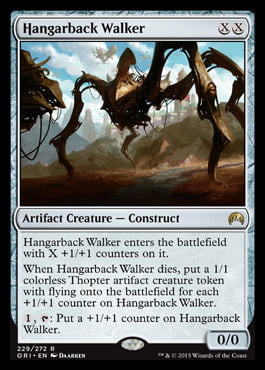
Welcome back to another “This week in Magic.” For this week’s topic, we’re going to cover what was played at Pro Tour Origins. Surprisingly, a many of the matches that were played out on camera were not the same deck over and over again. It was quite refreshing. In fact, if you were one of those lucky viewers you got to see Andrew Cuneo pilot a crazy UR Sphinx deck that definitely caught people by surprise. Sadly, though, he could only manage a 6-4 Standard record. Give him big props for maintaining a winning record at least. The deck of the weekend had to have been UR Thopters. Who saw this one coming? I’m not going to lie. Most of this deck comprises of glorified Limited cards. However, Standard seems to have slowed down just enough that it’s survivable to play these cards. Some would argue that the deck is, shockingly, just as fast as thanks to cards like Shrapnel Blast and Ensoul Artifact.
These cards have been around in Standard for quite some time, but, for some reason, only now has made a dent in the Standard format. Let’s break the deck down and find out why this deck was such a powerhouse at Pro Tour Origins.
UR Thopters by Mike Sigrist
Pro Tour Origins, 2nd place
Main Deck
4x Hangerback Walker
4x Ornithopter
4x Phyrexian Revoker
4x Chief of the Foundry
4x Whirler Rouge
3x Stubborn Denial
1x Collateral Damage
4x Ghostfire Blade
3x Springleaf Drum
4x Shrapnel Blast
4x Ensoul Artifact
4x Darksteel Citadel
4x Shivan Reef
4x Temple of Epiphany
1x Mana Confluence
1x Mountain
6x Island
1x Foundry of the Consuls
Sideboard
3x Disdainful Stroke
1x Rending Volley
4x Roast
3x Seismic Rupture
1x Negate
3x Thopter Spy Network
I think the biggest reason this deck was so successful was because of Hangerback Walker. This card is so powerful, I saw it in a lot of other decklists besides UR Thopters at the SCG Regional event (which took place the same weekend as Pro Tour Origins). Against early aggro decks, the big play was to play this guy on turn two making it a 1/1. For Mono Red players, they really had to think if they wanted to throw their creature into it, or use a burn spell on it. Either way, when it died, it left a 1/1 thopter in play to block the next guy.
You really have to deal with the walker right away or else it’s controller will start storing counters on it. If this begins to happen, then you’re really in trouble. Let’s talk about these other abilities. So, yes, the Walker costs XX to cast. Meaning that if you pay two mana, it will come into play with one +1/+1 counter on it. If you pay four mana, it will come into play with two counters on it, and so on. I initially thought this card would be a great late game play in slow control decks like UB Control. However, I failed to recognize it’s other abilities.
Even if you drop the Hangerback Walker onto the battlefield as early as turn two, it can still grow into a very large threat. Some of the best plays I watched being made with the artifact was blocking a creature, then activating it’s ability to add another counter. Now, the person facing the Walker had several options, either bite the dust and have their creature die, use a removal spell earlier than expected, or watch as the Walker died leaving a trail of Thopters behind.
In some cases it was necessary to destroy your own Walker. That’s where Shrapnel Blast came into play. Collateral Damage was more of a fifth copy of Shrapnel Blast, but since you can have only four, you can see the dilemma. One of the best plays of the entire Pro Tour utilized Shrapnel Blast and Hangerback Walker. At the end of another player’s turn, the controller of a Walker had blown it up thanks to a Shrapnel Blast dealing five damage to their opponent. This had also left them with three 1/1 flying Thopters. On their turn, they took their creatures and flew over their opponent’s dealing three more damage. To finish them off, they cast a game winning Wild Slash. That totaled 10 damage in a blink of an eye.
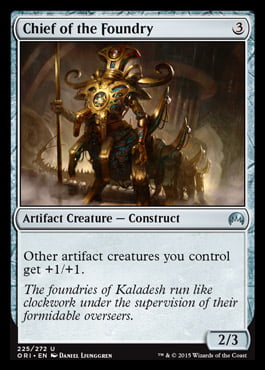
Chief of the Foundry is another welcomed addition that makes this deck more viable than ever. Previously, Ensoul Artifact decks weren’t doing enough to keep themselves afloat. Due to creatures like Whirler Rogue and, in some lists, Thopter Engineer, combined with Chief of the Foundry, the deck now has the reach it didn’t have before. There is nothing worse than staring down a fleet of thopters, especially thopters that have grown and are now 2/2’s or even 3/3’s.
UR Thopters is a very synergistic deck that can kill fast. It’s only downfall, it seems, is that it has terrible mulligans. If you watched the Pro Tour then you’ll know that Sigrist had one of the worst cases of a deck failing on him during the finals. It’s something that, as Magic players, we’ve all been through and know all too well. Don’t let this deter you from playing the deck. It’s one that will give grief to many other while it still exists in Standard.
About the author
Simeon is now the Community Manager for Battleground Games & Hobbies. If you have any questions or inquiries, then you can reach him at Sims@battlegroundgames.com. He is also an avid gamer who loves to play board games and video games. He graduated college with a degree in Political Science, and now serves the public by writing about games. You can check that out here. Don’t forget to “like” him on Facebook as well. It’ll update you on all of his newest content. Best of all, you can follow Simeon on Twitter (@SimeonCortezano) for some real time hilarity. Thanks for reading!
The Extra Life 2015 campaign is underway. Donate today!

Join the Battleground Games & Hobbies community forums!
Please don’t forget to check us out on Facebook and follow us on Twitter @battleground_gh!
Tags: Magic the Gathering, MTG, pro tour origins, Simeon Cortezano, Standard, ur thopters
Posted in Blog, Card Games, Featured Author, Featured Post, Magic: The Gathering, Popular Posts | No Comments »
- Products
- Buylist
- Policies
- Contact Us


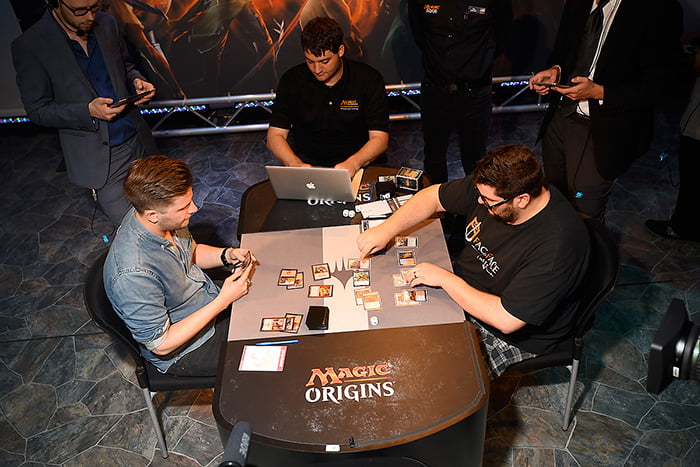
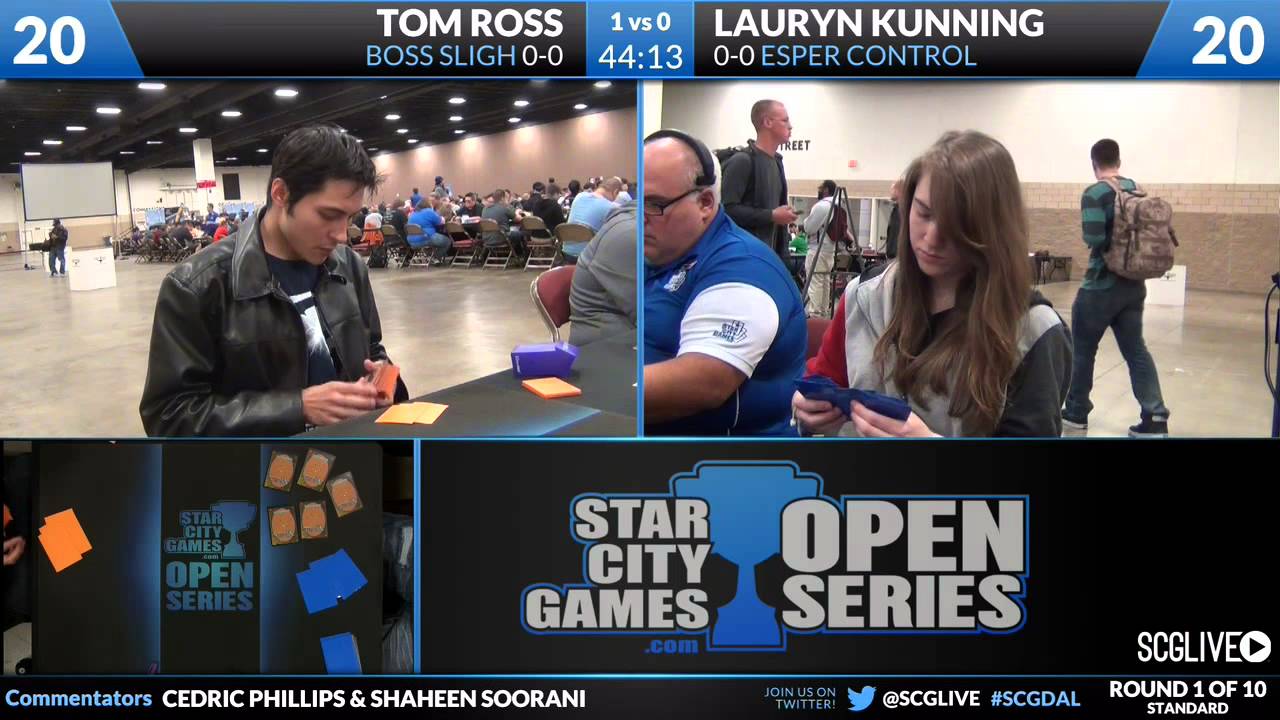


Social: